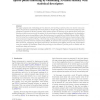Free Online Productivity Tools
i2Speak
i2Symbol
i2OCR
iTex2Img
iWeb2Print
iWeb2Shot
i2Type
iPdf2Split
iPdf2Merge
i2Bopomofo
i2Arabic
i2Style
i2Image
i2PDF
iLatex2Rtf
Sci2ools
CGF
2008
2008
Sparse points matching by combining 3D mesh saliency with statistical descriptors
This paper proposes new methodology for the detection and matching of salient points over several views of an object. The process is composed by three main phases. In the first step, detection is carried out by adopting a new perceptually-inspired 3D saliency measure. Such measure allows the detection of few sparse salient points that characterize distinctive portions of the surface. In the second step, a statistical learning approach is considered to describe salient points across different views. Each salient point is modelled by a Hidden Markov Model (HMM), which is trained in an unsupervised way by using contextual 3D neighborhood information, thus providing a robust and invariant point signature. Finally, in the third step, matching among points of different views is performed by evaluating a pairwise similarity measure among HMMs. An extensive and comparative experimental session has been carried out, considering real objects acquired by a 3D scanner from different points of vie...
| Added | 09 Dec 2010 |
| Updated | 09 Dec 2010 |
| Type | Journal |
| Year | 2008 |
| Where | CGF |
| Authors | Umberto Castellani, Marco Cristani, Simone Fantoni, Vittorio Murino |
Comments (0)

